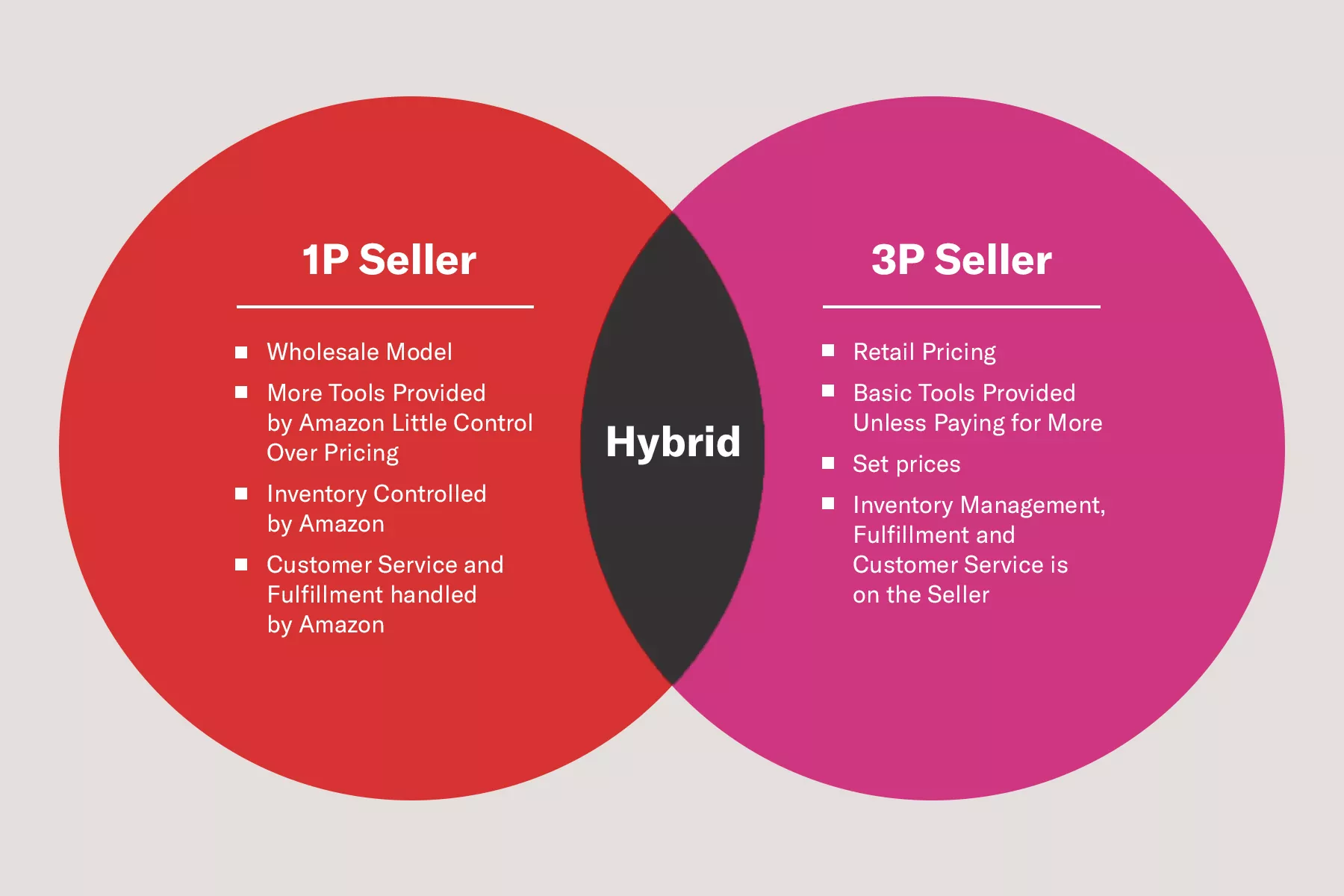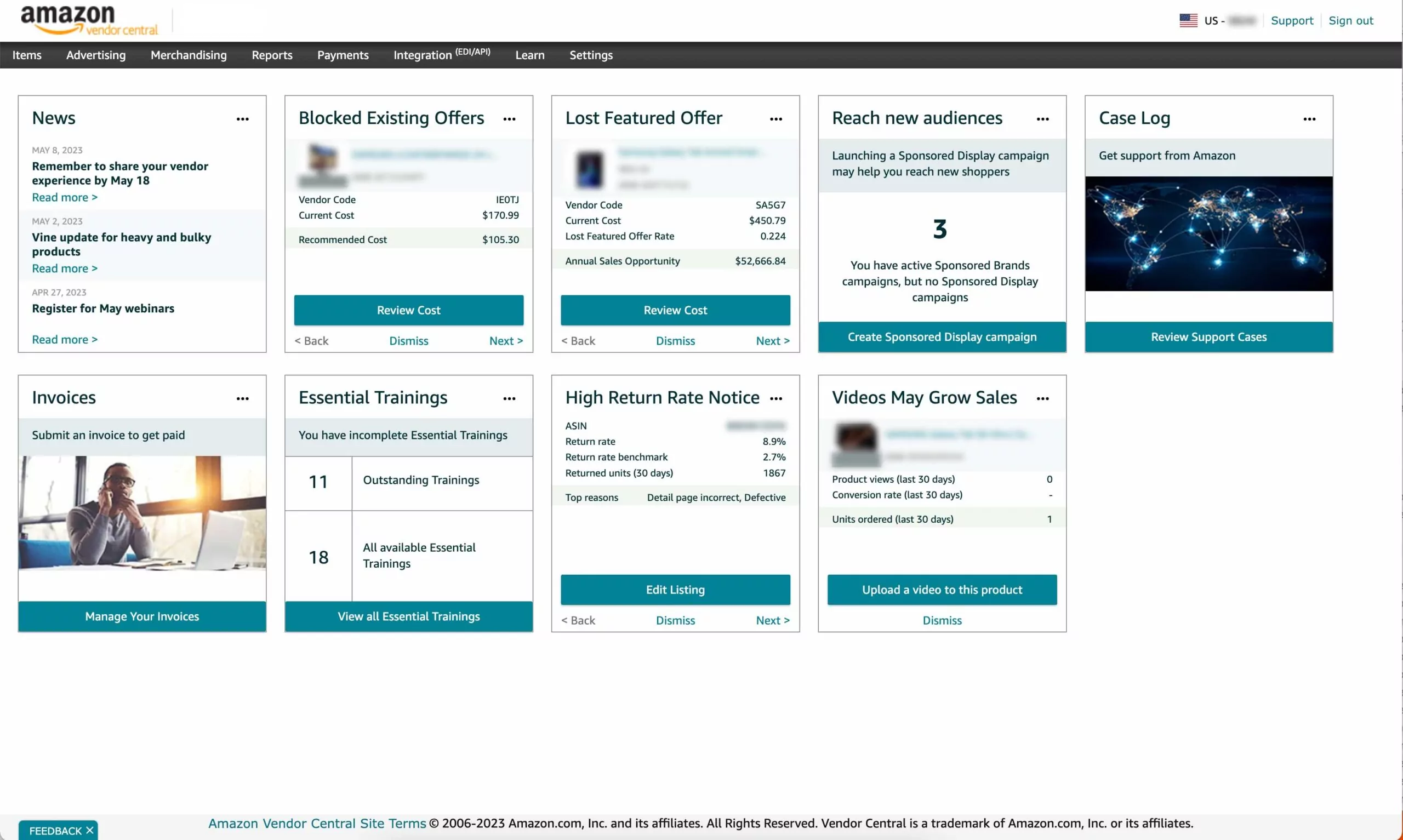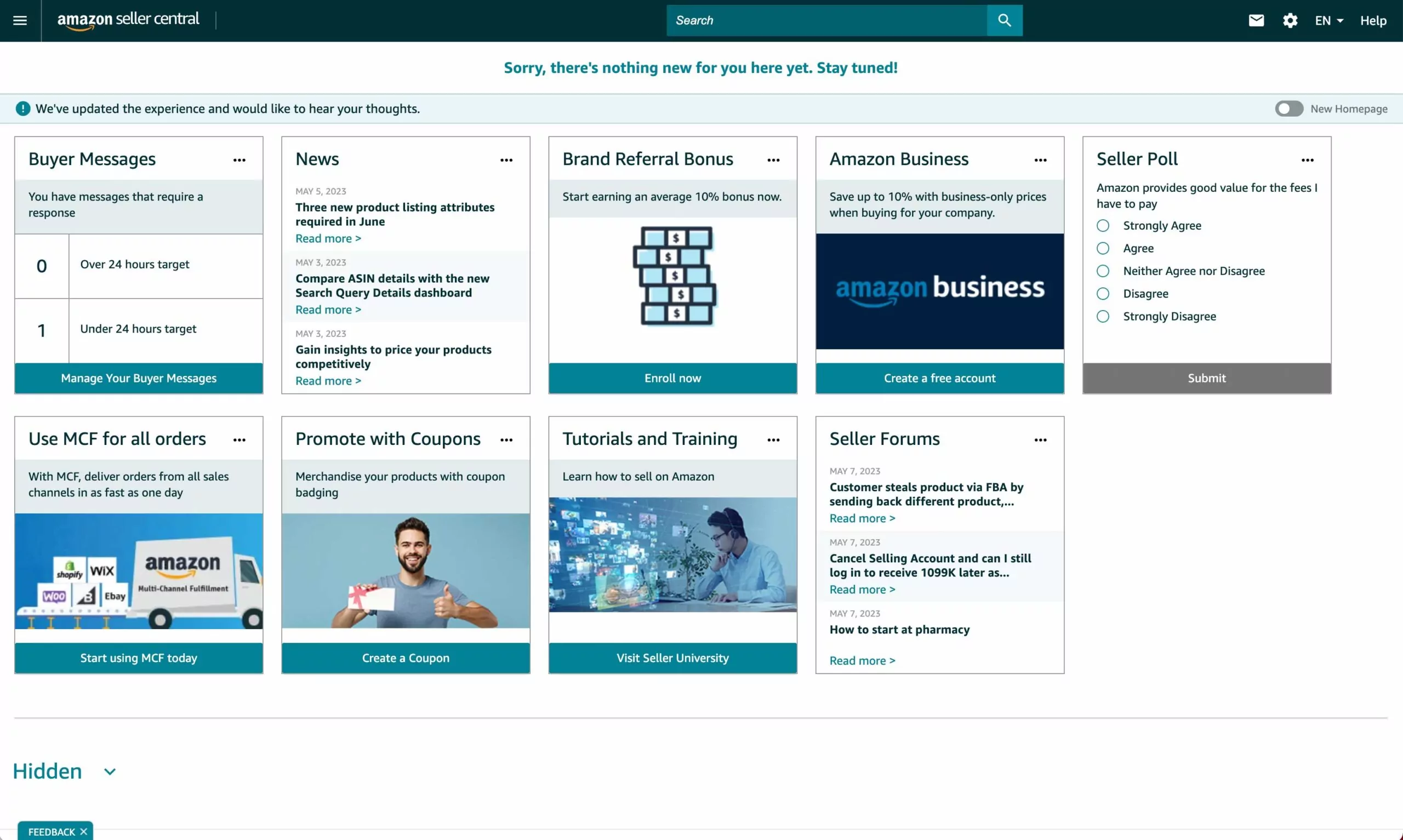Resources - Blog
1P vs. 3P vs. Hybrid: How to Choose the Best Selling Model

In today’s fast-paced digital world, e-commerce has become an integral part of almost every business. Amazon is undoubtedly the biggest player in this field, and it offers three different selling models: 1p, 3p, and hybrid. Each model has its own set of advantages and disadvantages, and choosing the right one depends on the individual needs of your business.
Below, we will discuss each selling model and their respective pros and cons to help you make an informed decision.

First-Party (1P) Selling Model
As a first-party seller, you sell your products directly to Amazon, who then sells them to customers. This model is also known as “wholesale” or “vendor” selling. In this model, Amazon purchases the product from the brand at a wholesale price and is responsible for selling and shipping the product to customers. This means they control pricing for your product as well.
Even though Amazon is now the “owner” and seller of your products, you are still responsible for setting up the item and providing some of the product content, which you can do from your Vendor Central account. You also have the ability to advertise and run promotions for your products, so they sell faster and Amazon continues to buy from you.

Here are the pros and cons of 1P selling:
20% of businesses on Amazon are 1Ps only
Feedvisor Proprietary Research 2023
Pros of 1P Selling
- Greater control over branding: As a first-party seller, you have more control over branding since Amazon is essentially acting as a retailer rather than a marketplace.
- Access to Amazon Retail Analytics (ARA): First-party sellers have access to ARA, which provides detailed data on sales, product performance, and customer behavior.
- Potential for higher sales volume: By selling directly to Amazon, you may be able to reach a larger audience and achieve higher sales volume.
- Amazon handles shipping and customer service: Amazon takes care of shipping and customer service, which can be a major advantage for brands that don’t have the resources to handle these tasks on their own.
- Higher chance of winning the Buy Box: This is an indirect pro, but 1p’s have a higher chance of winning the Buy Box, especially for sellers who don’t have a high seller rank or long history of selling on Amazon.
Cons of 1P Selling:
- Higher barriers to entry: Not everyone can choose to sell as a 1P, you must be invited by Amazon directly to sell in this capacity, which means meeting very strict criteria set by Amazon. Not all criteria is public knowledge, but being a nationally distributed brand with public success increases your chances of being asked.
- Limited control over inventory: As a first-party seller, you have less control over inventory since you are selling to Amazon rather than directly to customers.
- Less flexibility with pricing: Amazon determines the price of your product, which will be market-dependent and could lead to smaller profit margins. Amazon’s margins are even smaller, so they may push you to lower your wholesale prices so they can provide a lower cost to consumers. In some cases, when Amazon feels their margins are too small, products are automatically ineligible for advertising, hurting sales even more.
- Higher costs: First-party sellers may be required to pay for additional services, such as marketing and promotions, which can add to the overall cost of selling on Amazon.
- Risk of lost sales if Amazon decides not to order: Amazon has the power to decide which products to carry and how much to order, which means that brands selling through 1P are at risk of lost sales if Amazon decides to reduce or stop ordering their products.
- Less control over product images: In rare cases, Amazon will choose not to use your perfectly curated and designed image and instead use an image they take to promote your product. This can be very difficult to change back and result in loss of sales for poor imagery.
Third-Party (3P) Selling
As a third-party seller, you list your products on Amazon and sell them directly to customers. In this model, the seller is responsible for selling and shipping the product, and Amazon takes a commission on each sale. Third party sellers have three other fulfillment options: Fulfillment By Amazon (FBA), Fulfillment By Merchant (FBM) and Seller Fulfilled Prime (SFP). Each one has its own set of costs and advantages.
3P sellers log into Seller Central to manage their Amazon operations.

Here are the pros and cons of 3P selling:
6% of businesses on Amazon are 3Ps only
Feedvisor Proprietary Research 2023
Pros of 3P Selling:
- Control over pricing: Third-party sellers set their own prices, so they can directly impact their profit margins.
- More control over inventory: As a third-party seller, you have more control over inventory and can use your own fulfillment methods.
- Predictable Costs: Third-party sellers generally have flat rates for fees, so they can predict their costs and incorporate them into their pricing strategies..
- Access to a large customer base: Selling on Amazon’s marketplace can give brands access to millions of customers who are already shopping on the site.
Cons of 3P Selling:
- Responsible for all marketing: As a third-party seller, you have to create your product listing pages, product details, and all marketing that goes with it. This can be tough for those with larger catalogues.
- Limited access to customer data: Third-party sellers have limited access to customer data, which can make it difficult to track customer behavior and optimize sales.
- Competition: As a third-party seller, you’ll be competing with other sellers on Amazon, which can make it difficult to stand out and achieve high sales volume.
- Responsibility for shipping and customer service: Third-party sellers are responsible for shipping and customer service, which can be a challenge for businesses that don’t have the resources to handle these tasks on their own.
Hybrid 1P/3P Selling
A hybrid 1P/3P model involves selling some products as a first-party seller and others as a third-party seller. Overall, the hybrid model can offer sellers the best of both worlds, providing the benefits of the 1P and 3P models while minimizing their respective drawbacks. It’s important to note though, if you do go with this model, you will need to avoid selling the same products as a 1P and 3P to not jeopardize your selling status with Amazon. Carefully consider the costs and benefits of each model and choose the one that aligns with your business goals and resources.
Here are the pros and cons of a hybrid selling model:
74% of businesses on Amazon adopt hybrid selling models
Feedvisor Proprietary Research 2023
Pros of Hybrid Selling:
- Greater control over inventory: With a hybrid model, you have greater control over inventory, since you can use your own fulfillment methods for your third-party products.
- Control over pricing: You have more flexibility with pricing for your third-party products, since you set your own prices.
- Access to customer data: As a first-party seller, you have access to customer data for your first-party products, which can help you optimize sales, especially for your third party products.
- Diversification: By selling both as a first-party (1P) vendor and a third-party (3P) seller, a seller can diversify their sales channels and reduce the risk of lost sales if one channel experiences issues.
- Access to Amazon Retail Analytics: As a 1P vendor, a seller has access to Amazon Retail Analytics, which provides detailed data on sales, customer behavior, and inventory management. This can be a valuable tool for making informed business decisions.
- Testing new products: The hybrid model can be a good way for sellers to test new products on Amazon’s marketplace. By starting as a 3P seller and then transitioning to a 1P vendor once sales have grown, the seller can minimize risk and gain valuable insights into customer demand before committing to larger quantities.
Cons of Hybrid Selling:
- More complex: Selling in a hybrid model can be more complex than selling exclusively as a 1P or 3P seller. Sellers must manage inventory, pricing, and branding across two separate accounts and may need to develop different strategies for each.
- Increased competition: By selling in both the 1P and 3P channels, sellers may face increased competition from Amazon itself as well as other third-party sellers.
- Pricing conflicts: Pricing conflicts can arise if the seller is selling the same product in both the 1P and 3P channels. This can result in confusion for customers and may damage the seller’s reputation.
- Potential for account suspension: Amazon has strict rules around the use of the hybrid model, and sellers who violate these rules may be at risk of account suspension or other penalties.
- Higher fees: While using the hybrid model can help sellers reduce fees in some cases, it can also lead to higher fees overall if the seller is not careful about managing inventory and pricing.
Final Thoughts
Choosing the right selling model on Amazon depends on your individual business needs. If you are a manufacturer or distributor, the 1p selling model can be a good option (if invited). If you are a small business or a startup, the 3p selling model can be a better fit. For businesses that want to maintain both relationships with Amazon, the hybrid selling model is a good option.
Regardless of which model you choose, it is important to carefully weigh the pros and cons of each and develop a well thought-out strategy for selling on Amazon. Feedvisor’s team of experts and award-winning AI-driven platforms can help.
